Rolex Watches: The Evolution of the Submariner
Hello.
This is Seno from Vintage Watch Life.
In today's video, we will be introducing the Submariner, produced by Rolex, the most powerful brand in the wristwatch industry, and introducing the various models that have come before and explaining the features of each one.
Almost all things lose a lot of value when you buy them, but with this Submariner, the opposite is true; its value starts to increase from the moment you buy it.
To begin with, the structure is quite robust, meaning it can be used not only for a lifetime but even by your grandchildren, meaning you can trade with peace of mind.
If you watch today's video until the end, I believe you will come to love the Submariner even more, so please stay with us until the end.
The Birth of the Submariner and Its Present-Day Legacy
In the late 1940s, a growing number of scuba diving professionals were born, and a diving boom began among the general public as well.
Rolex then realized that professional divers wanted a waterproof watch that could be used at deep seas.
They began developing a diver's watch based on the concepts of "100% reliable water resistance against water pressure," "visibility that can be read even under dark water," and "ensuring the safety of divers by recording time."
As you know, the first Submariner was born in 1953 and was Rolex's first diver's watch.
The original model, Reference 6204, featured a robust stainless steel case and bracelet, a rotating bezel with a 60-minute scale for recording dive time, and was guaranteed waterproof to a depth of 100 metres.
The deep sea is darker than we can imagine, making visibility poor, so the indexes and hands are coated with radium luminous paint to ensure visibility in such environments, making it an indispensable support item for divers.
The following year, in 1954, Rolex released the Ref. 6200, which increased water resistance to 200m, and Rolex's diver's watches began to become popular among professionals.
Although the Submariner was a huge hit, it underwent a major model change in 1959.
The previous model had a 38mm case, but the new Ref. 5512 evolved into a 40mm case with a crown guard, giving it a more robust style.
This shape is the Submariner we are familiar with, and although there have been some improvements since 1959, it has not undergone any major changes and is an extremely long-selling model even among Rolexes.
Now, let's take a look at the Submariner, from the earliest model to the third-generation model.
By the way, the first three models are 38mm in size and do not have a crown guard.
Rolex Submariner First Model Ref:6204 Equipped with Cal.A260 movement
The birth of the first Submariner dates back to 1953.
The first model is thought to be the Ref. 6204.
Although it does not have a crown guard, there are not many differences compared to the current Submariner, and you can see that the design from that time has been retained.
Designed for professional divers, the Submariner was equipped with a rotating bezel that could record the elapsed time of the dive and was the first diver's watch guaranteed waterproof to a depth of 100 meters.
The movement is equipped with a full rotation unidirectional winding automatic winding caliber A260, and is housed in a waterproof Oyster case.
In this movement, the rotor can rotate in both directions, but the mainspring can only be wound in one direction.
The automatic movements of the time still had issues with their rotors, so they were thick and had a semi-bubble back that was bulged to prevent the rotor from hitting the watch.
The original was Ref. 6204, but it was changed to Ref. 6205 the following year, so it was only produced for a year, making it a rare model that can no longer be seen today.
There are two dial patterns: a mirror dial and a honeycomb dial with guilloche engraving.
In fact, there is the Ref. 6205, which is classified as the same first model, but although it was released in 1954, it quickly disappeared when the second model was released in 1955.
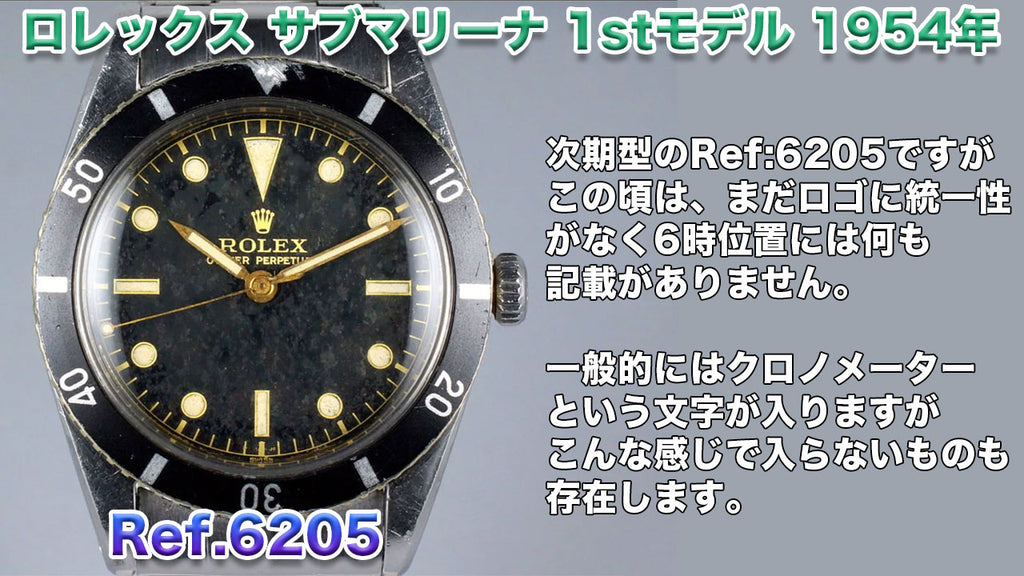
Now let's take a look at each of the dial shapes.
·needle
Both the hour and minute hands are pencil hands with radium luminous paint.
The second hand has a lollipop tip so that it can be easily identified even in the deep sea where visibility is poor.
Bezel
The minutes are written in 5-minute increments, with 10, 20, 30, 40, and 50 marked in Arabic numerals and the rest marked in bar indexes.
Crown

The crown comes with the crown mark and the Swiss "+" mark as default.
This concludes the introduction of the first model, but in the early days of the Submariner, a 200m water resistant model was also released at the same time.
So, next let's take a look at the 200m waterproof model, which is classified as the first model.
Rolex Submariner First Model Ref:6200 Equipped with Cal.A296 movement

Then, in 1954, the Ref. 6200 was born, with even improved water resistance.
Although the appearance looks the same as before, it is equipped with a larger crown than normal to achieve 200m water resistance.
This is commonly called a "big crown" and is a large crown with a diameter of 8 mm.
By making the crown larger, the seal rate can be increased, improving the waterproof performance.
In order to improve robustness, the case is also made thicker than that of the 100m waterproof version.
It is unclear whether this is to make it immediately obvious that the dial is water resistant to 100m, but only the 3, 6, and 9 numbers from the dot index are displayed in Arabic index, and the rest are displayed in bar index.
Because it has elements of both the Submariner and the Explorer, this model is recognized as the greatest Submariner of all time, and collectors call it the "King Sub."
The movement is the Ca I.A296, the successor to the Cal.A260, which was also installed in the 100m water resistant model. This movement also has a semi-bubble back as the thickness of the rotor has not yet been improved.
Now let's take a look at each of the dial shapes.
·needle
Both the hour and minute hands are made of radium, and this model is equipped with a "Benz hand" for the hour hand.
The second hand is a lollipop, just like the 100m water resistant model, but whereas the 100m indicator was located at the tip of the hand, on this model it is located slightly inside the index.
Bezel
The bezel is positioned the same as the 100m water resistant model.
Crown
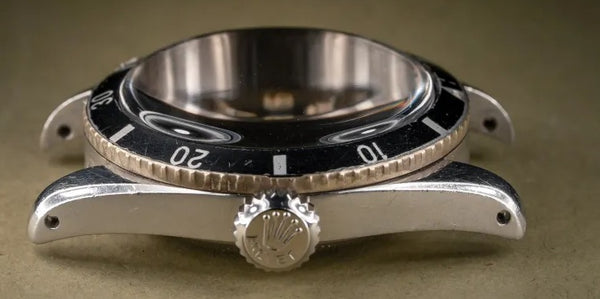
Under the crown mark, the word BREVET, which means "patent" in French, is written.
Now let's look at the second model.
Rolex Submariner Second Model Ref.6536/1 Equipped with Cal.1030 Movement

Rolex introduced the second generation Submariner, the Ref. 6536 and Ref. 6538, in 1955.
The Ref. 6536 is classified as the successor to the 100m water resistant model, while the Ref. 6538 is classified as the successor to the 200m water resistant model.
I will explain the 200m waterproof model Ref:6538 next.
These two models were released, but the 100m water resistant Ref. 6536 had the same thick case as the 200m water resistant Ref. 6538, which was too large for 100m water resistance, so production was discontinued after just one year. To fill the gap, the Ref. 6536/1 was quickly born, which used a thinner case.
The movement installed will also evolve to the next model.
Until then, the watch was bidirectional, but could only be wound in one direction, whereas the Cal. 1030 was installed, which could now be wound in both directions.
The entire movement has been redesigned, making the rotor thinner and resulting in a flatter case back, resulting in a thinner watch overall.
The dial is a mirror dial, and from this point on it begins to resemble the Submariner logo that we normally see.
At the 12 o'clock position, the "ROLEX" and "OYSTER PERPETUAL" logos will be printed in two lines, and at the 6 o'clock position, the "100m/330ft" and "SUB MARINER" logos will be printed, indicating the water resistance.
Some individual watches have "CHRONOMETER" underneath.
Now let's take a look at each of the dial shapes.
·needle
The hour, minute, and second hands are the same as those used in the Ref:6200 200m waterproof model.
Bezel
The bezel has evolved significantly.
Until then, the memory was arranged in 5-minute increments, but with this model the memory is arranged in 1-minute increments up to 15 minutes.
The memory that is still used in current models began with this second generation.
Crown

It is equipped with a 6mm crown to make it water resistant to 100m, and there is a "➖" mark under the crown mark.
The meaning of this '➖' is that it is a sign of Twin Lock and indicates that the water resistance is 100m.
Next, let's look at the 200m waterproof model.
Rolex Submariner Second Model Ref.6538 Movement: Cal.1030
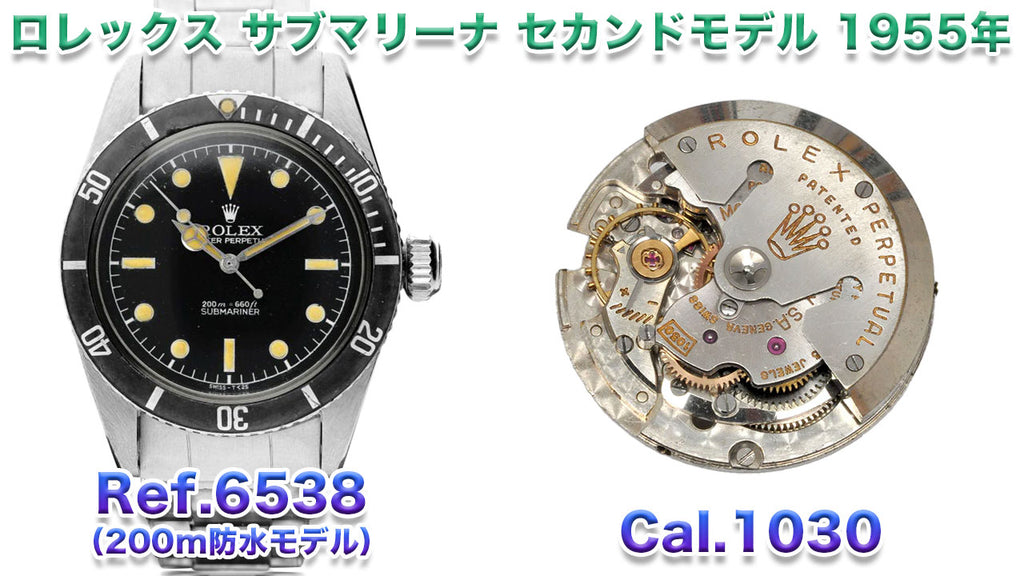
This second generation model was born in 1955 and is the successor to the first generation Ref. 6200.
This is one of the most popular Submariner models of all time because it was worn by Sean Connery as James Bond in the movie "007."
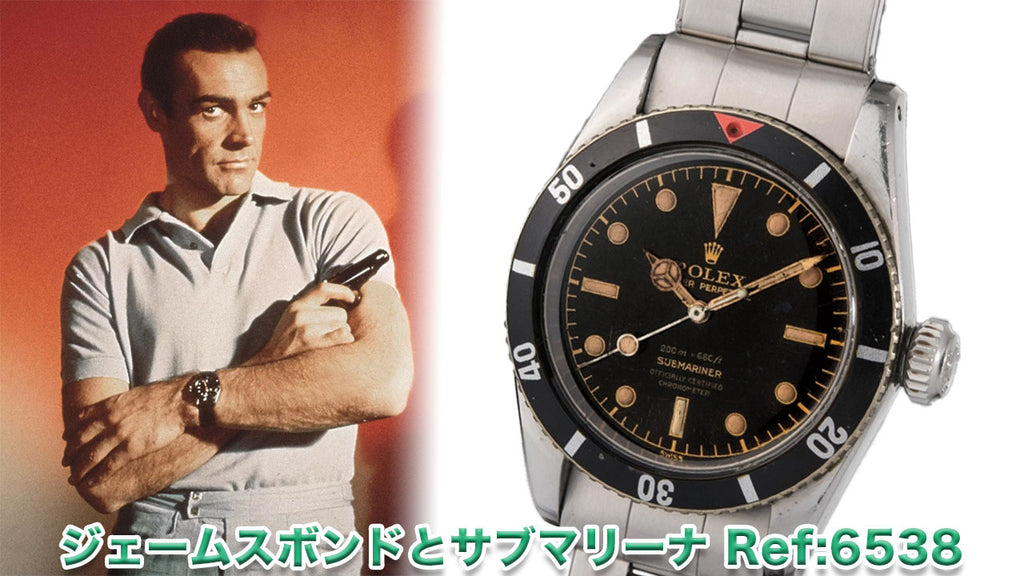
The sturdy, thick case is designed to withstand water pressure up to a depth of 200m and is equipped with a large 8mm crown.
The movement is Cal. 1030, the same as the 100m waterproof model.
The first model with a water resistance of 200m had an Explorer dial, but the second model was changed to the Submariner's iconic dot dial.
The dial is the same as the first model, but as mentioned earlier, the major changes are that one-minute markings have been added to the bezel and the triangular part of the zero pointer has been painted red.
Rolex Submariner Third Model Ref.5508 Movement: Cal.1530

Now let's take a look at the third generation Submariner, a 100m waterproof model.
The third generation was born in 1958, but the design is almost the same as the second generation.
What has changed is the movement, which has been changed to Cal. 1530, a member of the 1500 series of movements, which is considered one of the masterpieces of the time.
Like the first and second generations, the Ref. 5510 was also born, which was waterproof to 200m. However, production of the Ref. 5510 ceased after just one year. Although there were 200m models up to the third generation, very few documents remain, probably because they were produced in very small numbers.
This model was the final one not to feature a crown guard; crown guards were introduced from the fourth generation onwards.
The dial is almost the same as the second model, with no major changes.
An easy thing to see is that the red part of the 0 pointer has returned to silver.
However, upon closer inspection, we notice that the radium luminous paint at 6 o'clock on this third model has a dot underneath the bar index.
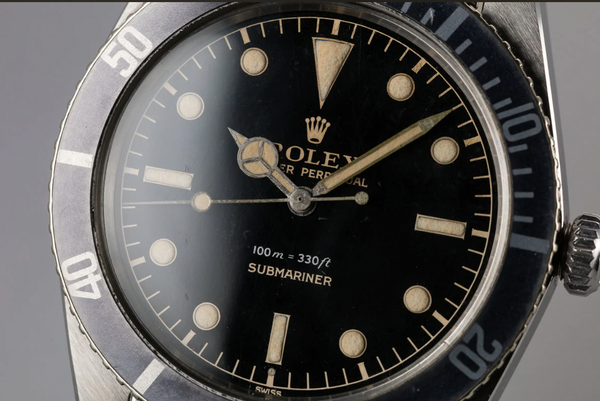
This is just my guess, but since there wasn't much change in appearance, I think they added it to improve visibility.
By the way, this is called an exclamation point overseas because it looks like an exclamation mark.
Summary of Crown
By looking at the crown, you can tell what the watch represents, so I have explained this up to now, but I think it was a little difficult to understand because there were only specific parts.
Here I will briefly summarise them.
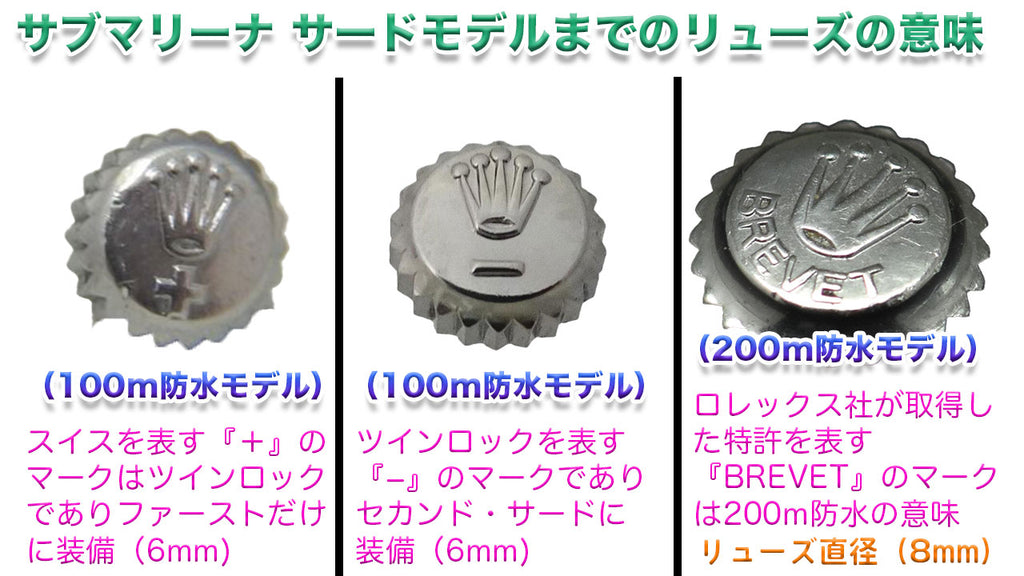
Please assume that these are the crowns of a Submariner.
First, the "+" mark on the far left is only used on the First and indicates that the Twinlock is water resistant to 100m.
It is water resistant to 100m and the crown diameter is 6mm.
Next, the crown in the middle has a "-" mark indicating that it is Twinlock water resistant to 100m.
In short, both the "+" and "-" indicate the Twinlock's 100m water resistance, and the only thing that has changed is the way it is written, from "+" to "-".
Of course, since it is waterproof to 100m, the diameter of this crown is 6mm.
The last crown on the far right is engraved with "BREVET," which represents the 200m water resistance patent that Rolex obtained.
Therefore, in order to achieve 200m water resistance, the crown size is 8mm, which is larger than the 100m model.
Of course, most crowns have been replaced by now, so please use this as a reference point to make your decision.




